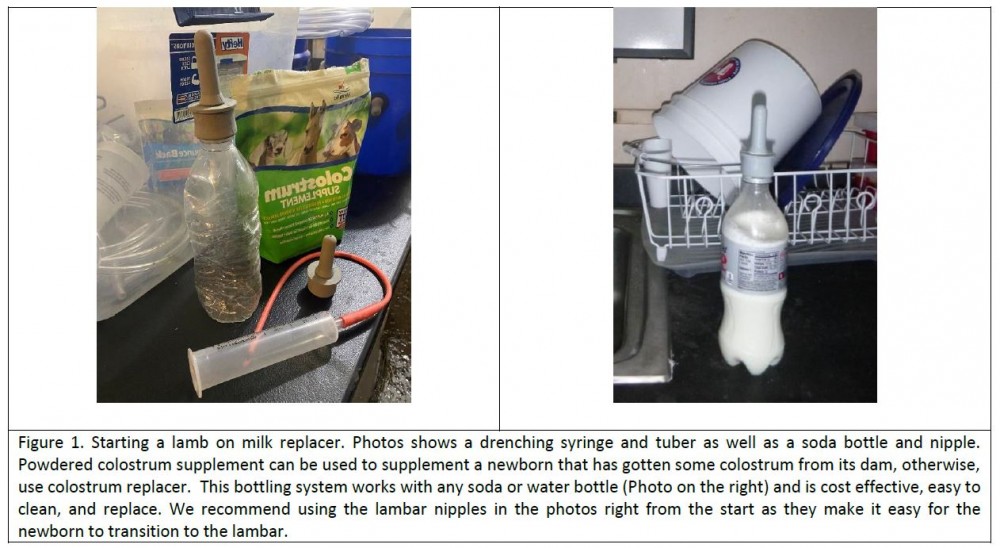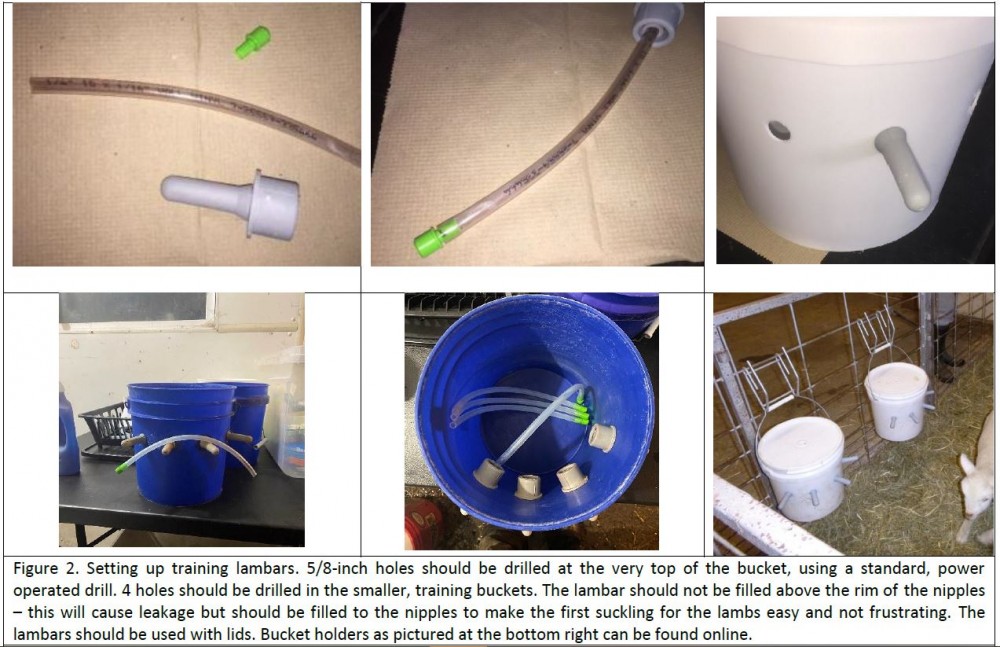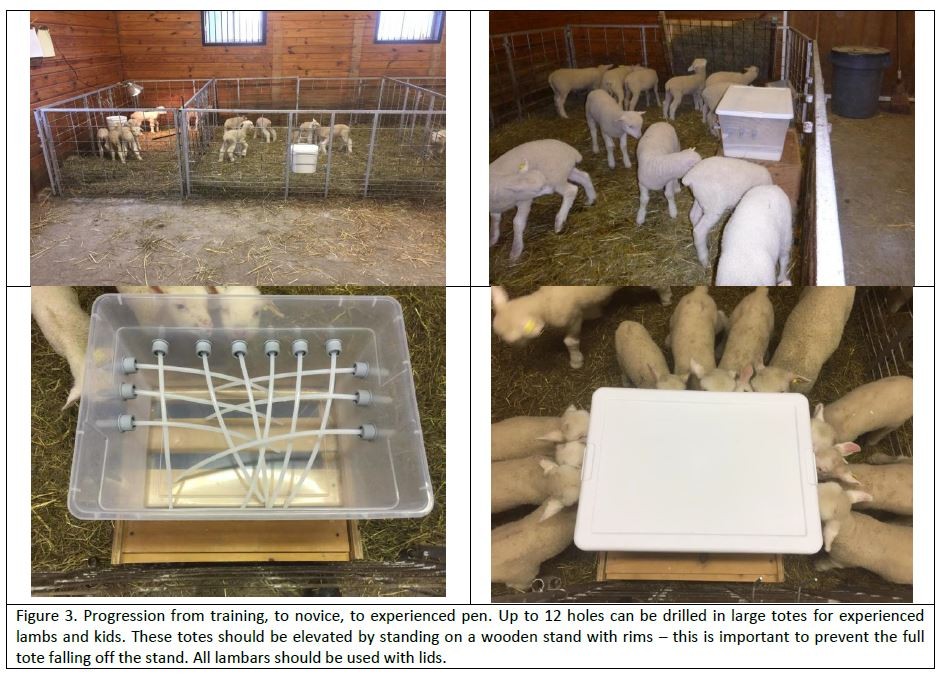Overview of the Cold Milk Lambar System used at Cornell University
This fact sheet was originally published by the Cornell Sheep and Goat Program
Overview of the cold milk lambar system used at Cornell University
The cold-milk lambar system is simple. It was developed by Ken Fredriksen at the USDA Sheep Experiment Station at Dubois, Idaho in the 1960s. A lambar is a set of nipples connected to tubes that go to the bottom of a container of cold milk. The nipples are specially designed with a flange to fit through at 5/8-inch hole. The tubing fits just inside the nipple. The lambar system forces the lambs to suck to get milk and prevents pneumonia (compared to gravity milk feeders). Feeding cold milk replacer helps in two ways: 1) it prevents the milk from spoiling and 2) it prevents lambs and kids from drinking too much at once as they may do if the milk is fed warm. They soon adapt to consuming many small meals, mimicking the nursing pattern of naturally reared offspring. Heat lamps (properly secured!) can be used in the artificial rearing pens to keep newborn lambs or kids comfortable.
Lambs and kids may have to be reared artificially if their dam dies or sickens, refuses its offspring, or has multiples and not enough milk supply. Generally, the sooner a starving lamb or kid can be removed from their dam - the better the outcome will be. If the newborn lamb or kid cannot nurse colostrum from its dam, obtain fresh or frozen colostrum from another female in your flock or buy commercial powdered colostrum replacer to mix with warm water. If the newborn lamb or kid is unwilling to suck from a bottle, use the tubing method to supply them with warm colostrum (10% of their bodyweight over 2 or 3 feedings in the first 24 hours). If fed colostrum replacer rather than sufficient colostrum from a vaccinated dam, offspring will need tetanus and enterotoxemia antitoxin to be protected short term against these diseases.
 Click to enlarge.
Click to enlarge.Starting lambs and kids on milk replacer
A hungry lamb or kid is easier to start on a bottle than a neonate with a full stomach is. Wait about 4 hours after its last natural milk (or colostrum) intake, to try to get a lamb or kid to nurse from a bottle for the first time. Depending on its age, use either warm milk or colostrum for the first feeding (drops of milk should feel warm but not hot on the back of your wrist). Place the lamb or kid on the floor (standing) between your knees with its butt behind you. Put the nipple in its mouth and clamp its mouth over the nipple holding your hand the top of its head and eyes until it starts suckling. Don't let it chew on the nipple. Let it suckle as much warm milk as it likes. Four hours later (or overnight) repeat this step except now use cold milk.
 Click to enlarge.
Click to enlarge.Mixing milk replacer and setting up lambars
We use a very high-quality lamb milk replacer that also includes decoquinate to prevent coccidiosis. Milk replacer can easily be mixed with cold water in 5-gallon buckets with a large whisk. Buckets with cold milk can be stored in a refrigerator for multiple days if only a few animals are artificially reared. We recommend measuring out water and powder once, and then using markers to indicate required amounts on buckets and measuring cups. Add half of the required water to the powder, whisk, add the rest of the water, whisk again.
 Click to enlarge.
Click to enlarge.Feeding lambs and kids on the lambar system
Cold milk is available in lambars at all times, i.e., lambs and kids are fed ad libitum. To start them on the lambar system, use one-way valves at the bottom of lambar tubes to keep milk at the top. This prevents new lambs from becoming discouraged because they are rewarded right away when they first suck on the nipples. It is important to place them at the nipple frequently over the course of 2 days or until they independently use the lambar. Put the nipple in its mouth and clamp its mouth over the nipple holding your hand the top of its head and eyes until it starts suckling. Don't let it chew on the nipple. Let it suckle as much milk as it likes. Once the lambs or kids are "trained" on the lambars, they can move from the training to the "novice" pen, where the only difference is that the lambars do not require one-way valves. They move on to the "experienced" pen once they are well trained on the lambar without one-way valves and their milk intake has increased. There they are offered cold milk replacer from plastic tote boxes with no valves in the tubes. Milk is kept cold by adding frozen bottles or jugs of water to the lambar or tote box.
Supply List:
- Small lambar buckets with lid, 2 gallons
- Larger tote, container with lid
- Nipples
- One-way valves
- 5/8-inch vinyl tubing
- Drill and 5/8-inch drill bit
- Bucket holders
- Colostrum replacer (not supplement)
- Milk replacer
- 5-gallon bucket with lid to mix/store milk replacer
- Wisk
- Soda or water bottles
- Wooden stand with rims for tote
Follow-up by Dr. tatiana Stanton:
Below are results for 284 artificially raised dairy lambs (evenly distributed among lambing months), taken off their dam at <12h, from a 2-year study on campus between 2017 and 2019. We exclusively used the lambar system described in the factsheet:
 Data from the artificially raised lamb trial. Click to enlarge.
Data from the artificially raised lamb trial. Click to enlarge.Upcoming Events
WNY Pastureland Conversion & Soil Health Field Day
July 16, 2025
Middleport, NY
Join American Farmland Trust for the Western New York Soil Health Field Day on July 16, 2025, at Zeliff Farm in Middleport, NY, from 9:00 AM-3:15 PM. Learn about pasture conversion, soil health benchmarking, biochar in grazing systems, and best grazing practices. Plus, enjoy hands-on demos with the NY Soil Health Trailer, drones, and cover crops! Check out the attached agenda for more information about the field day and REGISTER HERE. Zeliff Farms is a regenerative beef operation who has recently partnered with AFT on outreach and education to farmers including learning circles and evaluating biochar effects on soil health.
IPM Strategies to Protect Corn and Soybean Seed in NY
July 30, 2025
Hamburg , NY
SWNYDLFC and Cornell IPM are hosting a grower meeting to discuss integrated pest management strategies for protecting corn and soybean seed in New York.
FAMACHA Training for Sheep and Goat producers in Woodhull NY
August 13, 2025 : FAMACHA Training in Woodhull
Woodhull, NY
Join us for a discussion and hands-on training for internal parasite integrated pest management in sheep and goats. Certification is available to all students participating in the workshop.
Announcements
No announcements at this time.





